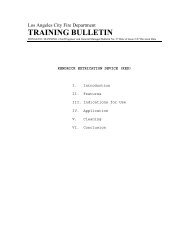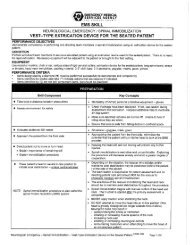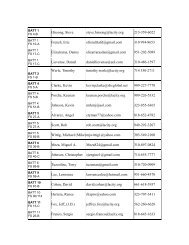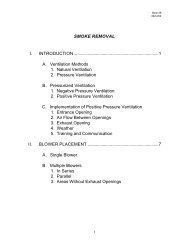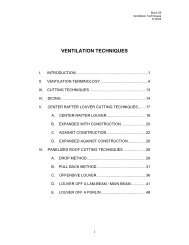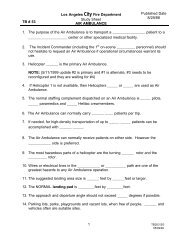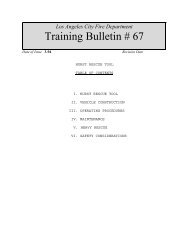Book 35 - EMS Field Manual - LAFD Training
Book 35 - EMS Field Manual - LAFD Training
Book 35 - EMS Field Manual - LAFD Training
You also want an ePaper? Increase the reach of your titles
YUMPU automatically turns print PDFs into web optimized ePapers that Google loves.
Section 1: <strong>Field</strong> Procedures 1 Protocols<br />
TASK ORIENTED <strong>EMS</strong> STANDARD OPERATING GUIDELINES<br />
<strong>EMS</strong> Standard Operating Guidelines (SOGs) are intended as guidelines to establish pre-determined<br />
, tasks for each member of the company. Company Commanders shall assign taskslresponsibilities<br />
based upon the expertise of each team member. Additionally, the tasks designated for each of the<br />
following four positions are not intended to supersede any pre-existing duties assigned to the member.<br />
The medical condition of the patient determines the work flow and sequencing of tasks.<br />
\<br />
. ./Â¥<br />
A-B<br />
Person<br />
c<br />
Person<br />
D<br />
Person<br />
E<br />
Person<br />
The "A-B" (Airway-Breathing) person who assesses the airway; applies oxygen;<br />
determines the respiratory rateltidal volume; and any signs of distress while<br />
checking breath sounds. In cases of cardiac or respiratory arrest, the "A-B" person<br />
inserts the airway and performs bag-valve-mask (BVM) ventilation.<br />
The "C" (Circulation) person is responsible for preserving the circulation by stopping<br />
any overt bleeding, and obtains the pulselrate and blood pressure. For pulseless patients:<br />
applies the automated external defibrillator (AED); attempts defibrillation; and provides<br />
chest compressions for CPR, as necessary.<br />
The "D" (Disability) person is responsible for preventing further patient disability by<br />
assessing the current degree of disability and applies splintslspinal immobilization as<br />
necessary. In cardiac arrest cases: assists with equipment needs (such as oxygen bottles,<br />
backboard, and gurney); assists the paramedics with IV line preparation and equipment<br />
needs. In many situations, the fourth member of the company is unavailable since the<br />
Engineer has apparatus responsibilities. However, the Engineer may assist the rescue<br />
as described above and may be able to assist when the patient is outside of a structure.<br />
The "E" (Executive) person ensures that all of the other team members are properly<br />
performing their tasks. In cardiac arrest cases, the "E" person assists the "C" person<br />
set up the automated external defibrillator (AED) to ensure rapid application. The "E"<br />
person assesses the scene for safety, initiates the F-902M, keeps records of interventions<br />
and their delivery times, interacts with family members to obtainlrecord patient<br />
information which includes: medical history, allergies, a current medications list,<br />
current address (include ZIP code), and (if available) Medi-Cal number.<br />
Even when dispatched simultaneously (with an ALS unit), fire company members<br />
shall perform the above tasks (including defibrillation) as a team.<br />
Suggested personnel for each <strong>EMS</strong> team assignment and equipment to be carried to the patient:<br />
A-B<br />
c<br />
D<br />
E<br />
FF or FF/PM<br />
Firefighter<br />
Engineer or A0<br />
Captain<br />
Revised: 121200 1 PAGE 1 OF 4<br />
Oxygen, BVM, and airway<br />
managementJsuction bag<br />
AED and medical box<br />
Flashlight, splints, backboard,<br />
gurney as needed<br />
F-902M and Radio<br />
tf



